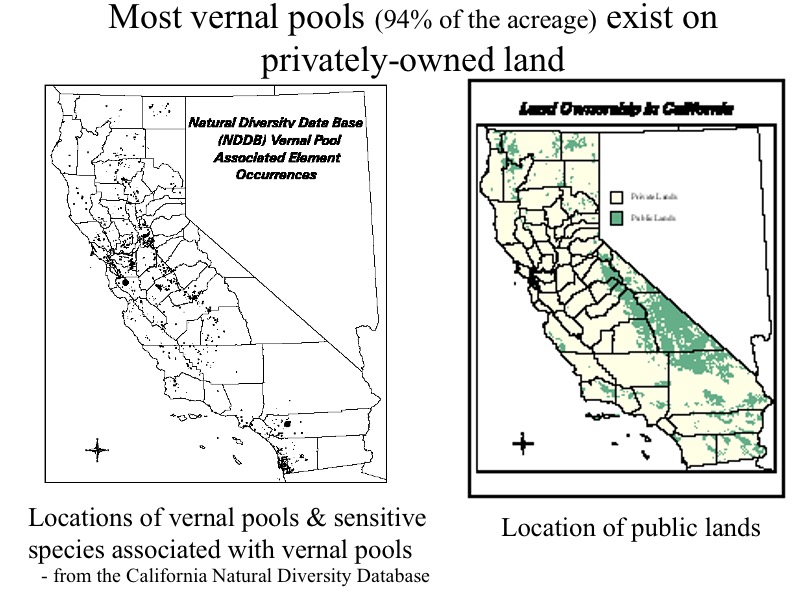Edaphic factors that favor native species in grasslands
Some edaphic factors may help discourage growth of non-native species, allowing native species to dominate. In grasslands, examples of this include native-dominated grassland patches on serpentine soils and native-dominated plant communities in vernal pools.
Serpentine soils
Serpentine soils develop from the weathering of serpentine rock, California's state rock. Serpentine rock forms through metamorphic processes as igneous rock (peridotite) interacts with water in subduction zones. Due to California's large number of geologic faults and subductions zones, California has more than it's fair share of serpentine soil.
Serpentine soil presents numerous challenges to plant growth.
- It is high in heavy metals, such as chromium, iron, cobalt, and nickel
- It has a high Mg:Ca ratio. (This is important because plants take up Mg and Ca with the same transporter. Therefore, a high Mg:Ca ratio in the soil can decrease calcium uptake.)
- It is low in important soil macronutrients (nitrogen, phosphorus, and potassium).
- It is generally thin and rocky. A thin layer of soil over rock has very little water-holding capapcity, so the soil dries out more quickly in the spring than deeper soils.
Many plant species that are native to California can tolerate these conditions to some extent. Some are found exclusively on serpentine soil. Introduced species, however, tend to fare poorly on serpentine soil. As a result, competition from introduced species is low on serpentine soil, and serpentine soil tends to...
- support many serpentine endemics
- serve as a refuge for many native grassland species
The image below is of Stanford University's Jasper Ridge Biological Preserve. The yellow band is a band of serpentine soil on which native wildflowers are growing. The green is non-serpentine soils that supports a grassland dominated by introduced annual grasses.

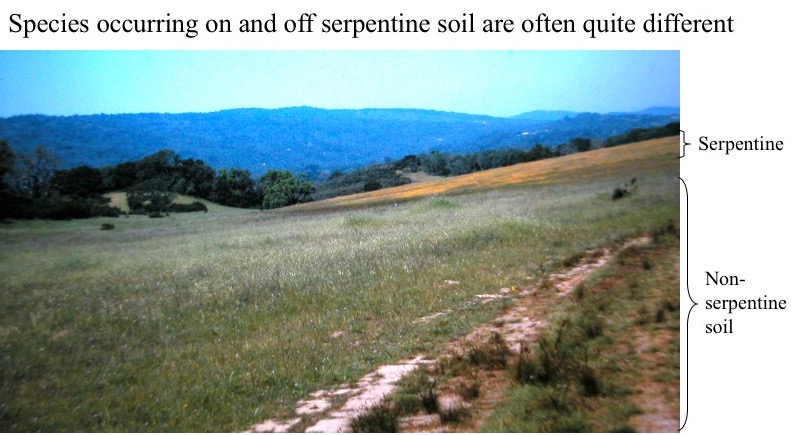
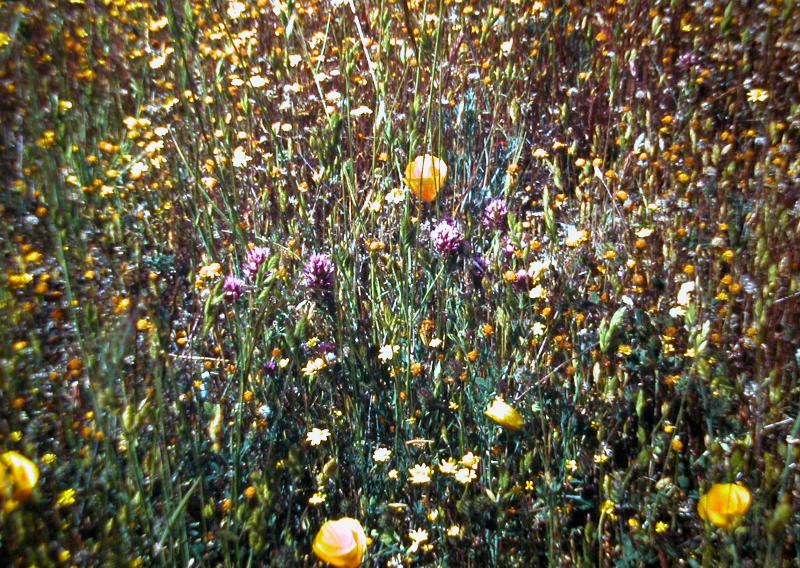
Note: Most plants on serpentine, including serpentine endemics, do better on non-serpentine soil.
They may be restricted to serpentine (or occur more commonly there) because they cannot tolerate competition with the other species occurring off of serpentine.
Some serpentine endemics are very narrowly distributed. One example, Calochortus tiburonensis (Tiburon mariposa lily) is a serpentine endemic that is found only on Ring Mountain in the San Francisco Bay area.

Since serpentine outcrops or groups of serpentine outcrops are widely separated, a species that evolves to tolerate serpentine soil in one locality may not be able to disperse easily to other serpentine areas. This may be the reason we find some serpentine endemics with very narrow geographic distributions.
Vernal pools
Vernal pools are places in grasslands where we also find high concentrations of native species. "Vernal" means springtime. Vernal pools are pools that exist during the winter and spring, but dry up later in the spring. They are caused by an impermeable layer under the soil surface that prevents water drainage and causes water to pond.
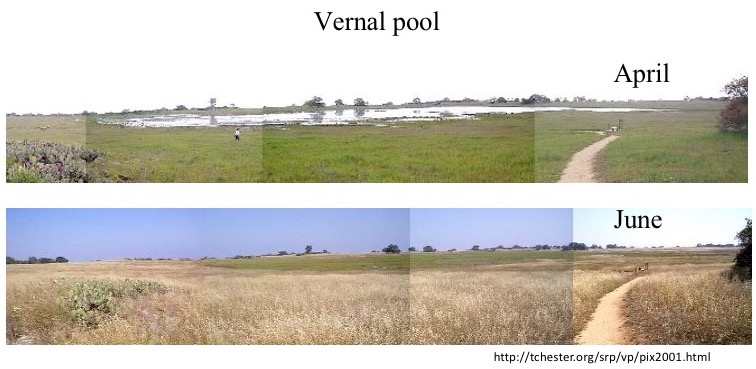
A complete photo series of seasonal changes of a vernal pool, from winter through the following fall, may be viewed at http://tchester.org/srp/vp/pix/mp_2001.html
Many plants cannot tolerate the environment of a vernal pool.
- Flooding causes roots of most species to "drown". (Roots need oxygen, and oxygen diffuses very slowly through still water.) Flood-tolerant plants tend to have air channels in the plant body that transport gases like oxygen from the shoot to the root.
- Drying (drought) causes a different stress. Plant species may have various characteristics that allow them to tolerate drought (to be discussed later).
- Few species have characteristics that allow them to tolerate both flooding and drought.
Species that tolerate the vernal pool environment are ephemeral species. These are annuals that complete their life cycle quickly and go to seed. They typically germinate as waters recede, flower quickly and die. They tolerate the drought and then the early flooding as seed only.
Since different species germinate under slightly different conditions and tolerate slightly different conditions, vernal pool species often flower in rings as the pool dries.
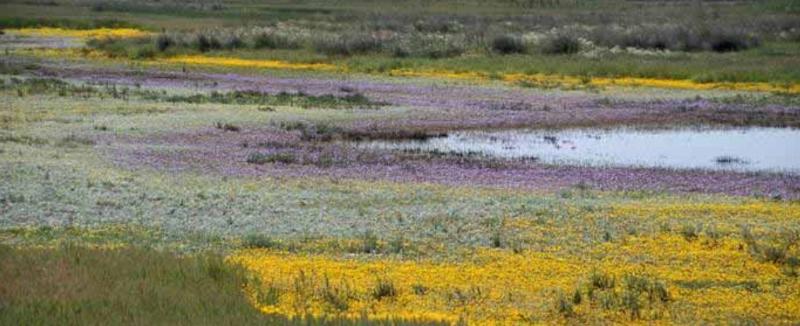
Some plant species are endemic to vernal pools. Some are more widespread natives that simply tolerate vernal pool conditions.
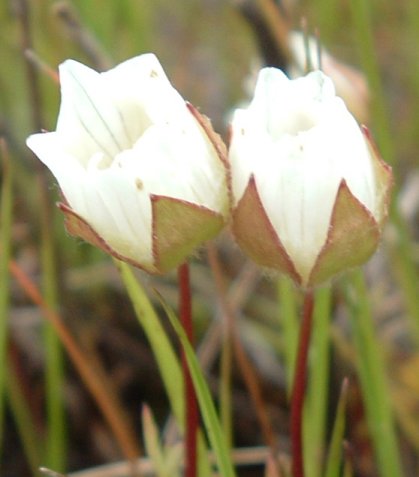
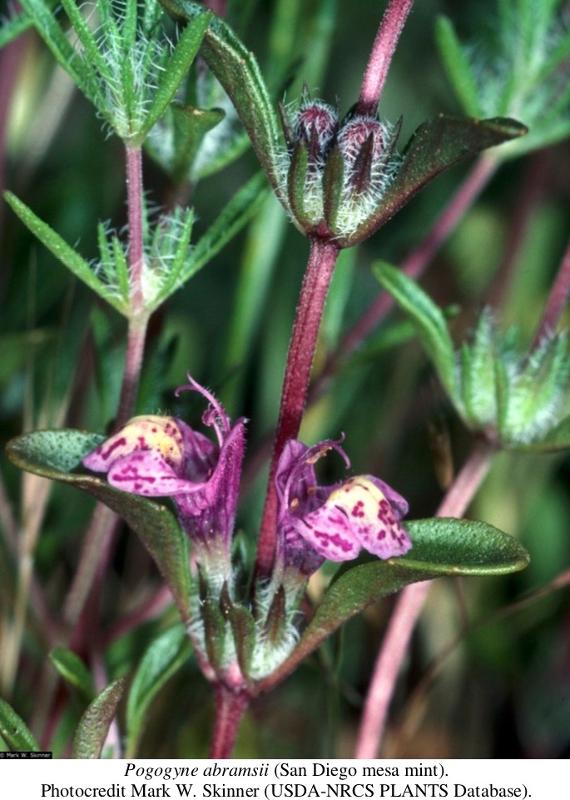
Some species that are endemic to vernal pools have very narrow geographic distributions. For example,
Butte county meadowfoam is endemic to vernal pools of Butte County (only).
San Diego Mesa mint is endemic to vernal pools of San Diego County (only).
Vernal pool endemics are of particular conservation concern because...
- Some species have very narrow geographic ranges.
- Economic forces (development, agricutlure, etc.) tend to favor draining these pools
- Vernal pools are surprisingly difficult to recreate once the impervious soil layer that causes them to form is disrupted
- Most vernal pools are on private land, rather than protected public lands
The maps below show the distribution of vernal pools in California and the distribution of public lands. There is very little overlap.
